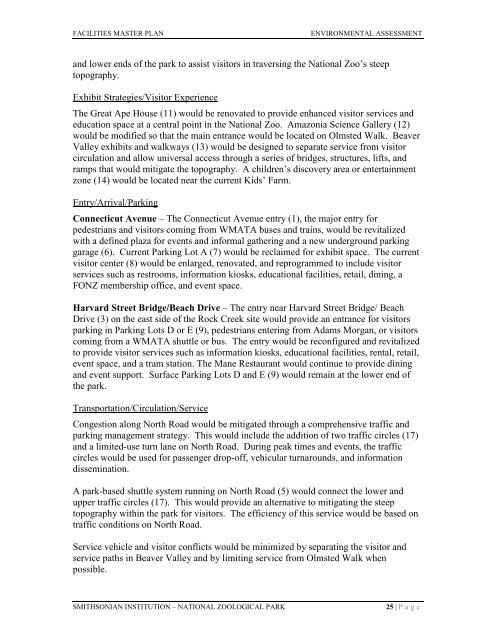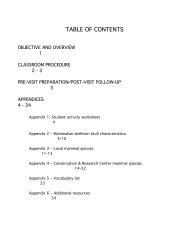facilities renewal master plan - National Zoo - Smithsonian Institution
facilities renewal master plan - National Zoo - Smithsonian Institution
facilities renewal master plan - National Zoo - Smithsonian Institution
You also want an ePaper? Increase the reach of your titles
YUMPU automatically turns print PDFs into web optimized ePapers that Google loves.
FACILITIES MASTER PLAN ENVIRONMENTAL ASSESSMENT<br />
and lower ends of the park to assist visitors in traversing the <strong>National</strong> <strong>Zoo</strong>’s steep<br />
topography.<br />
Exhibit Strategies/Visitor Experience<br />
The Great Ape House (11) would be renovated to provide enhanced visitor services and<br />
education space at a central point in the <strong>National</strong> <strong>Zoo</strong>. Amazonia Science Gallery (12)<br />
would be modified so that the main entrance would be located on Olmsted Walk. Beaver<br />
Valley exhibits and walkways (13) would be designed to separate service from visitor<br />
circulation and allow universal access through a series of bridges, structures, lifts, and<br />
ramps that would mitigate the topography. A children’s discovery area or entertainment<br />
zone (14) would be located near the current Kids’ Farm.<br />
Entry/Arrival/Parking<br />
Connecticut Avenue – The Connecticut Avenue entry (1), the major entry for<br />
pedestrians and visitors coming from WMATA buses and trains, would be revitalized<br />
with a defined plaza for events and informal gathering and a new underground parking<br />
garage (6). Current Parking Lot A (7) would be reclaimed for exhibit space. The current<br />
visitor center (8) would be enlarged, renovated, and reprogrammed to include visitor<br />
services such as restrooms, information kiosks, educational <strong>facilities</strong>, retail, dining, a<br />
FONZ membership office, and event space.<br />
Harvard Street Bridge/Beach Drive – The entry near Harvard Street Bridge/ Beach<br />
Drive (3) on the east side of the Rock Creek site would provide an entrance for visitors<br />
parking in Parking Lots D or E (9), pedestrians entering from Adams Morgan, or visitors<br />
coming from a WMATA shuttle or bus. The entry would be reconfigured and revitalized<br />
to provide visitor services such as information kiosks, educational <strong>facilities</strong>, rental, retail,<br />
event space, and a tram station. The Mane Restaurant would continue to provide dining<br />
and event support. Surface Parking Lots D and E (9) would remain at the lower end of<br />
the park.<br />
Transportation/Circulation/Service<br />
Congestion along North Road would be mitigated through a comprehensive traffic and<br />
parking management strategy. This would include the addition of two traffic circles (17)<br />
and a limited-use turn lane on North Road. During peak times and events, the traffic<br />
circles would be used for passenger drop-off, vehicular turnarounds, and information<br />
dissemination.<br />
A park-based shuttle system running on North Road (5) would connect the lower and<br />
upper traffic circles (17). This would provide an alternative to mitigating the steep<br />
topography within the park for visitors. The efficiency of this service would be based on<br />
traffic conditions on North Road.<br />
Service vehicle and visitor conflicts would be minimized by separating the visitor and<br />
service paths in Beaver Valley and by limiting service from Olmsted Walk when<br />
possible.<br />
SMITHSONIAN INSTITUTION – NATIONAL ZOOLOGICAL PARK 25 | P a g e

















